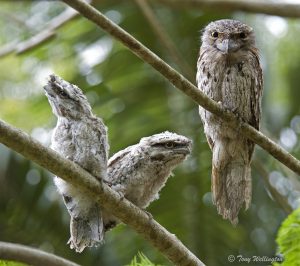TAWNY FROGMOUTH
Bird life with Tony Wellington The Tawny Frogmouth is not an owl as many people assume. In fact, they are more closely related to Nightjars. They don't have strong curved talons on their feet like owls. The genus name for these birds is Podargus, which is Greek for gout. That's because they're said to walk like a gout-ridden human. Tawny Frogmouths can survive in a wide range of habitats. A breeding pair may take up residence in the same territory for a decade or more. Both male and female take turns sitting on the eggs, though males prefer the daytime shift. Both adults develop brood patches during nesting - bald belly areas without feathers that can better transfer heat from parent to egg. Male and female hitch-up for life. Male birds have been observed gently stroking their mate with their beak. When one of a pair accidentally dies, the remaining bird will often grieve, making a mournful whimpering sound. The surviving bird will remain near to the fatality site for a few days and nights, neither eating nor drinking. The bulk of the diet is made up of insects, worms, slugs and snails. Moths seem to be a favourite. Tawny Frogmouths can also take small mammals, reptiles, frogs and other birds. I liken them to Kookaburras, as they carry out the same sort of feeding behaviour as those giant kingfishers, only at night. They will generally sit on a low branch or post, scanning the ground for movement. They pounce on their prey, grabbing it in their beaks. A study of day roosts for Tawny Frogmouths found that a pair will use up to 71 different roost sites, rarely using any single roost for more than 3 days. …

